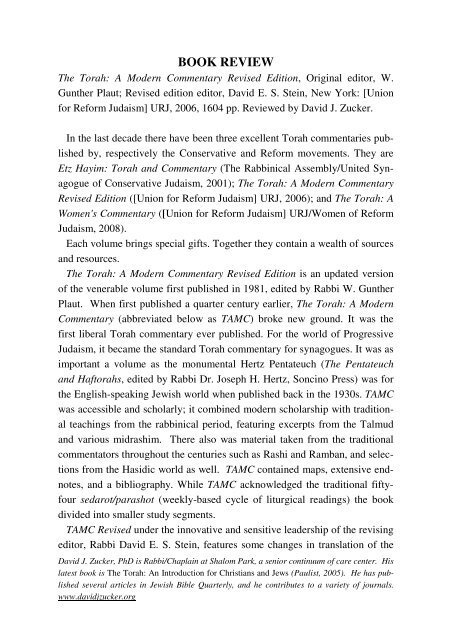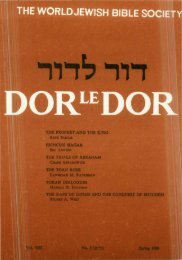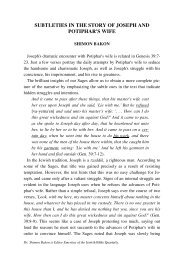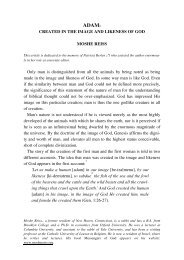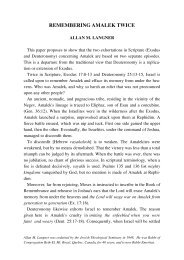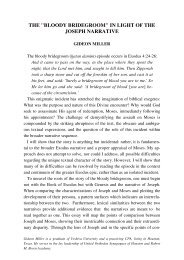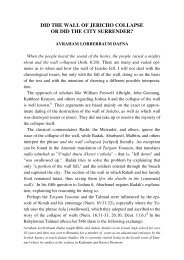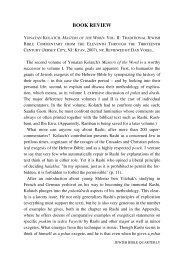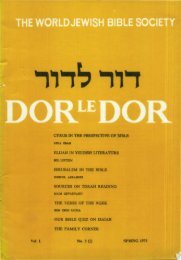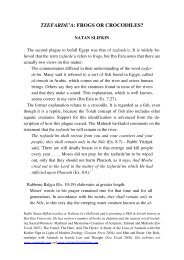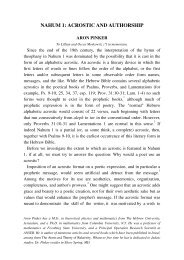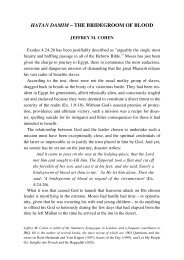The Torah: A Modern Commentary, Revised Edition - Jewish Bible ...
The Torah: A Modern Commentary, Revised Edition - Jewish Bible ...
The Torah: A Modern Commentary, Revised Edition - Jewish Bible ...
Create successful ePaper yourself
Turn your PDF publications into a flip-book with our unique Google optimized e-Paper software.
BOOK REVIEW<br />
<strong>The</strong> <strong>Torah</strong>: A <strong>Modern</strong> <strong>Commentary</strong> <strong>Revised</strong> <strong>Edition</strong>, Original editor, W.<br />
Gunther Plaut; <strong>Revised</strong> edition editor, David E. S. Stein, New York: [Union<br />
for Reform Judaism] URJ, 2006, 1604 pp. Reviewed by David J. Zucker.<br />
In the last decade there have been three excellent <strong>Torah</strong> commentaries published<br />
by, respectively the Conservative and Reform movements. <strong>The</strong>y are<br />
Etz Hayim: <strong>Torah</strong> and <strong>Commentary</strong> (<strong>The</strong> Rabbinical Assembly/United Synagogue<br />
of Conservative Judaism, 2001); <strong>The</strong> <strong>Torah</strong>: A <strong>Modern</strong> <strong>Commentary</strong><br />
<strong>Revised</strong> <strong>Edition</strong> ([Union for Reform Judaism] URJ, 2006); and <strong>The</strong> <strong>Torah</strong>: A<br />
Women's <strong>Commentary</strong> ([Union for Reform Judaism] URJ/Women of Reform<br />
Judaism, 2008).<br />
Each volume brings special gifts. Together they contain a wealth of sources<br />
and resources.<br />
<strong>The</strong> <strong>Torah</strong>: A <strong>Modern</strong> <strong>Commentary</strong> <strong>Revised</strong> <strong>Edition</strong> is an updated version<br />
of the venerable volume first published in 1981, edited by Rabbi W. Gunther<br />
Plaut. When first published a quarter century earlier, <strong>The</strong> <strong>Torah</strong>: A <strong>Modern</strong><br />
<strong>Commentary</strong> (abbreviated below as TAMC) broke new ground. It was the<br />
first liberal <strong>Torah</strong> commentary ever published. For the world of Progressive<br />
Judaism, it became the standard <strong>Torah</strong> commentary for synagogues. It was as<br />
important a volume as the monumental Hertz Pentateuch (<strong>The</strong> Pentateuch<br />
and Haftorahs, edited by Rabbi Dr. Joseph H. Hertz, Soncino Press) was for<br />
the English-speaking <strong>Jewish</strong> world when published back in the 1930s. TAMC<br />
was accessible and scholarly; it combined modern scholarship with traditional<br />
teachings from the rabbinical period, featuring excerpts from the Talmud<br />
and various midrashim. <strong>The</strong>re also was material taken from the traditional<br />
commentators throughout the centuries such as Rashi and Ramban, and selections<br />
from the Hasidic world as well. TAMC contained maps, extensive endnotes,<br />
and a bibliography. While TAMC acknowledged the traditional fiftyfour<br />
sedarot/parashot (weekly-based cycle of liturgical readings) the book<br />
divided into smaller study segments.<br />
TAMC <strong>Revised</strong> under the innovative and sensitive leadership of the revising<br />
editor, Rabbi David E. S. Stein, features some changes in translation of the<br />
David J. Zucker, PhD is Rabbi/Chaplain at Shalom Park, a senior continuum of care center. His<br />
latest book is <strong>The</strong> <strong>Torah</strong>: An Introduction for Christians and Jews (Paulist, 2005). He has published<br />
several articles in <strong>Jewish</strong> <strong>Bible</strong> Quarterly, and he contributes to a variety of journals.<br />
www.davidjzucker.org
128<br />
DAVID J. ZUCKER<br />
biblical text. <strong>The</strong> first edition had incorporated the New <strong>Jewish</strong> Publication<br />
Society (NJPS) version (<strong>Torah</strong>, 1962, 1967; Nevi'im 1978), whereas the <strong>Revised</strong><br />
<strong>Edition</strong> incorporated a recent rendition of the book of Genesis and of<br />
the haftarot, freshly rendered in the 1990s by the late Rabbi Chaim Stern.<br />
Stein served as the revising translator for the books of Exodus through Deuteronomy.<br />
In its own way, TAMC <strong>Revised</strong> is a seismic shift, certainly in terms of language.<br />
"<strong>The</strong> most prominent feature . . . is its use of 'the Eternal' to render the<br />
divine name YHVH. That usage dates back to 1783, when the famous scholar<br />
Moses Mendelssohn published his translation of the <strong>Torah</strong> into German. It<br />
was he who first rendered YHVH as ‘der Ewige’ (the Eternal) . . . <strong>The</strong> root<br />
meaning of the divine name in Hebrew is 'to be,' and the name 'Eternal' renders<br />
that name according to its meaning rather than its sound. That is, it conveys<br />
the overtones that an ancient Israelite would have heard when encountering<br />
YHVH as a name" (TAMC <strong>Revised</strong>, xxv).<br />
Another major consideration for the editors was gendered language regarding<br />
God. A primary issue was to "counter misunderstanding" that the <strong>Bible</strong>'s<br />
masculine references to God are pointing to a male deity (TAMC <strong>Revised</strong>,<br />
xxix). <strong>The</strong>y wished to make clear that the <strong>Jewish</strong> God is beyond human<br />
gender categories. <strong>The</strong> translators utilize a wide range of approaches. "He<br />
said, His people, His covenant, His voice," became "[God] said, God's<br />
people, the Covenant, the divine voice."<br />
"<strong>The</strong> second, more intensive . . . adaption . . . focused on the intersection of<br />
grammatical gender with social gender" (TAMC <strong>Revised</strong>, xxvi.) At times the<br />
biblical text's grammatical masculine wording refers to men (only) and sometimes<br />
to men and women (together). <strong>The</strong> NJPS translation had already<br />
sought a way to represent the text's plain meaning in idiomatic English.<br />
Like the NJPS translators, the revising translators sought "to render the<br />
Hebrew text as they believed the original author of that text meant it to be<br />
understood" (TAMC <strong>Revised</strong>, xxviii). This meant that if social gender was<br />
germane in the Hebrew text, it was rendered exclusively, and if it was not<br />
germane, then an inclusive term was used. For Exodus through Deuteronomy,<br />
the TAMC <strong>Revised</strong> used NJPS as its base version, although the new editors<br />
found ways to improve the contextual accuracy in certain passages with<br />
JEWISH BIBLE QUARTERLY
BOOK REVIEW: THE TORAH: A MODERN COMMENTARY (REVISED EDITION)<br />
regard to gender. In the Preface to this <strong>Revised</strong> <strong>Edition</strong>, examples are clearly<br />
provided. A few illustrations where there were differences include:<br />
GENDER NOT AT ISSUE IN THE HEBREW TEXT – NJPS RENDERED IN MASCULINE<br />
TERMS:<br />
Deuteronomy 22:26<br />
(NJPS) one man attacking another and murdering him<br />
(TAMC <strong>Revised</strong>) one party attacking and murdering another<br />
GENDER AT ISSUE IN THE HEBREW TEXT – NJPS RENDERED IN NEUTRAL TERMS<br />
Numbers 1:2<br />
(NJPS) take a census of the whole Israelite community<br />
(TAMC <strong>Revised</strong>) take a census of the whole Israelite company [of<br />
fighters]<br />
In addition to these grammatical considerations, this <strong>Revised</strong> <strong>Edition</strong> offered<br />
several innovations. Divisions are now by sidrah/parashah and all material<br />
has been reorganized accordingly. Some material formerly found in the<br />
Introductions now appears as essays. (This primarily applies to Leviticus.) A<br />
slanted line (/) encloses new comments regarding translation issues.<br />
As the commentary to the text offers alternative ways of considering a matter,<br />
so likewise do the essays. <strong>The</strong> essays reflect the fact that the <strong>Bible</strong> often<br />
is purposely vague. In the contemporary world, where "we are prone to say<br />
'either . . . or,' the <strong>Bible</strong> may say 'both' and let the unresolved tension between<br />
the two stand without further comment" (TAMC <strong>Revised</strong>, xliv).<br />
New in this edition are commentaries for the haftarot (additional prophetical<br />
readings) excerpted, thoroughly re-edited and supplemented from W.<br />
Gunther Plaut's Haftarah <strong>Commentary</strong>. In the Hebrew text of the <strong>Torah</strong>,<br />
traditional aliyah divisions (sections for public readings) are clearly delineated,<br />
as are those for when there are combined sidrah readings. Cantillation<br />
and accent marks are more clearly set out (TAMC <strong>Revised</strong>, xxiv).<br />
As in the original version, there is an extensive bibliography that lists <strong>Bible</strong><br />
translations, midrashic and post-midrashic collections. <strong>The</strong>re also are references<br />
Vol. 38, No. 2, 2010<br />
129
130<br />
DAVID J. ZUCKER<br />
to apocryphal and hellenistic sources available in English, medieval codes<br />
and philosophical works, commentaries from earlier centuries and from the<br />
20 th century, as well as commentary aids. William W. Hallo has updated his<br />
introductions to each of the books of the <strong>Torah</strong>. As in the earlier volume,<br />
there are extensive – and here additional – endnotes. This new volume contains<br />
several other features that will interest biblical students. <strong>The</strong>re is a correlation<br />
of variant verse numbering in the <strong>Torah</strong>, as opposed to some other<br />
editions of the <strong>Torah</strong>; an index to prophetic passages, and a very valuable<br />
Subject Index for Book and Sidrah Introductions, Translations, <strong>Commentary</strong><br />
and Essays.<br />
Extensive documentation is available online regarding details of editing the<br />
Hebrew text and its translation, as well as a list of corrections made in various<br />
printings; see http://www.urjpress.com/torahrevision/documentation.html<br />
.<br />
As noted earlier, Plaut's original commentary published in 1981 figuratively<br />
was earth shattering; it was the first ever comprehensive liberal commentary<br />
to the <strong>Torah</strong>. This volume, <strong>The</strong> <strong>Torah</strong>: A <strong>Modern</strong> <strong>Commentary</strong> <strong>Revised</strong><br />
<strong>Edition</strong> by Rabbi David E. S. Stein significantly enhances the earlier volume.<br />
Its focus on the intersection of grammatical gender with social gender, and its<br />
conscious choice of appropriate gendered language regarding God allows it<br />
to be faithful as to how the ancients heard these words millennia ago. This is<br />
an immeasurable gift to the contemporary reader. <strong>The</strong> <strong>Torah</strong>: A <strong>Modern</strong><br />
<strong>Commentary</strong> <strong>Revised</strong> <strong>Edition</strong> honors the past as it speaks to the present.<br />
JEWISH BIBLE QUARTERLY


